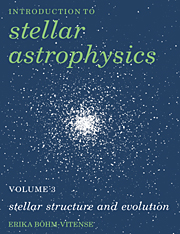Book contents
- Frontmatter
- Contents
- Preface
- 1 Introduction
- 2 Hydrostatic equilibrium
- 3 Thermal equilibrium
- 4 The opacities
- 5 Convective instability
- 6 Theory of convective energy transport
- 7 Depths of the outer convection zones
- 8 Energy generation in stars
- 9 Basic stellar structure equations
- 10 Homologous stars in radiative equilibrium
- 11 Influence of convection zones on stellar structure
- 12 Calculation of stellar models
- 13 Models for main sequence stars
- 14 Evolution of low mass stars
- 15 Evolution of massive stars
- 16 Late stages of stellar evolution
- 17 Observational tests of stellar evolution theory
- 18 Pulsating stars
- 19 The Cepheid mass problem
- 20 Star formation
- Appendix Radiative energy transport in stars
- Problems
- References
- Index
16 - Late stages of stellar evolution
Published online by Cambridge University Press: 08 January 2010
- Frontmatter
- Contents
- Preface
- 1 Introduction
- 2 Hydrostatic equilibrium
- 3 Thermal equilibrium
- 4 The opacities
- 5 Convective instability
- 6 Theory of convective energy transport
- 7 Depths of the outer convection zones
- 8 Energy generation in stars
- 9 Basic stellar structure equations
- 10 Homologous stars in radiative equilibrium
- 11 Influence of convection zones on stellar structure
- 12 Calculation of stellar models
- 13 Models for main sequence stars
- 14 Evolution of low mass stars
- 15 Evolution of massive stars
- 16 Late stages of stellar evolution
- 17 Observational tests of stellar evolution theory
- 18 Pulsating stars
- 19 The Cepheid mass problem
- 20 Star formation
- Appendix Radiative energy transport in stars
- Problems
- References
- Index
Summary
Completely degenerate stars, white dwarfs
In Chapter 14 we saw that low mass stars apparently lose their hydrogen envelope when they reach the tip of the asymptotic giant branch. What is left is a degenerate carbon–oxygen core surrounded by a helium envelope. The mass of this remnant is approximately 0.5 to 0.7 solar masses depending perhaps slightly on the original mass and metal abundances. The density is so high that the electrons are partly or completely degenerate except in the outer envelope. We also saw that central stars of planetary nebulae seem to outline the evolutionary track of these remnants which decrease in radius, still losing mass and increasing their surface temperature. Their luminosities do not seem to change much until they reach the region below the main sequence (see Fig. 14.14). In the interiors these remnants are not hot enough to start any new nuclear reactions. When they started to lose their hydrogen envelope they still had a helium burning and a hydrogen burning shell source. When the hydrogen envelope is lost the hydrogen burning shell source comes so close to the surface that it soon becomes too cool and is extinguished. The helium burning shell source survives longer but finally is also extinguished, when the star gets close to the white dwarf region. The remnant ends up as a degenerate star with no nuclear energy source in its interior but which still has very high temperatures. This is the beginning of the evolution of a white dwarf. It loses energy at the surface, which is replenished by energy from the interior, i.e. by thermal energy from the heavy particles.
- Type
- Chapter
- Information
- Introduction to Stellar Astrophysics , pp. 206 - 212Publisher: Cambridge University PressPrint publication year: 1992

